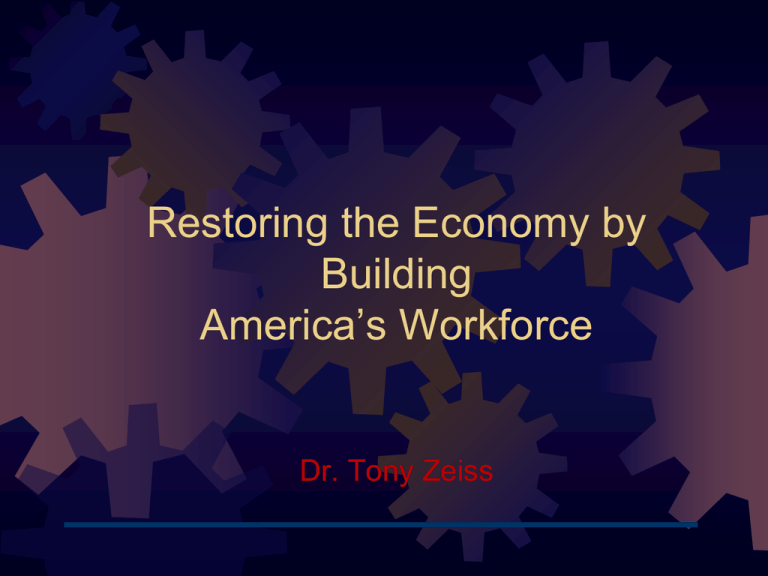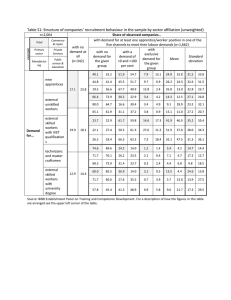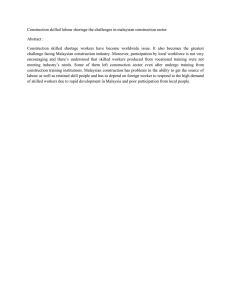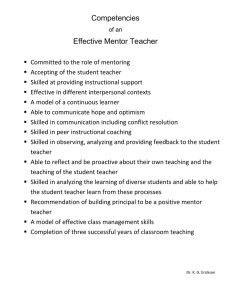Restoring the Economy by Building America's Workforce
advertisement

Restoring the Economy by Building America’s Workforce Dr. Tony Zeiss I. What Drives the Economy? II. Economic Recovery III. Workforce Trends IV. A Call for Action Wake Up Call # 1 Threat To The Economy Lack of Skilled & Productive Workers Alan Greenspan # 1 Threat To Your State (Your Community) Lack of Skilled & Productive Workers “America is facing the greatest labor & skills shortage in its history!” Hard Facts 10 million worker shortage in 2011. - U. S. Bureau of Labor Statistics A crisis in finding skilled labor. - National Association of Manufactures; Senator Tom Harken Health care providers & public schools are desperate for skilled labor~ -Get’em While They’re Hot Dr. Tony Zeiss Hard Facts Baby boomers are retiring. Succeeding generations are smaller. Low skilled jobs are becoming obsolete or moving offshore. Higher skilled jobs are replacing lower skilled jobs. America’s talent pool is decreasing; China’s & India’s are increasing. Evolving leadership gap.~ Education Required Projected Growth in Supply and Demand of Workers With Some Postsecondary Education, 1998 to 2028 . Jobs requiring some postsecondary experience Workers with some postsecondary experience 150,000 140,000 130,000 Thousands 120,000 110,000 100,000 90,000 80,000 70,000 60,000 1998 2008 2018 Source: Bureau of Labor Statistics, U.S. Census Bureau and National Alliance of Business 2028 Hard Facts U. S. is losing manufacturing jobs. 80% of creativity & innovation. We must continue to be creative & innovative. Jobs of the Future require higher skills & knowledge. 40% to 60% of jobs in 2015 don’t exist~ Good News Those organizations that prepare for the labor & skill shortage will do well! Providing a reliable supply chain of skilled workers is critical (and can be done). Most workers are prepared by community & technical colleges. Good News Most outsourced corporate education is provided by community colleges. Community Colleges are driving much of the economy (A great source of skilled employees; very responsive).~ Our Challenge Meeting Citizen and Employer Needs of the 21st Century The Happy Plumber I. What Drives the Economy? People and their Ability to Produce! Economic Powers Will Be Those Who… Compete well. Produce well. Use info & info networks well. Educate well. Produce skilled workers.~ Colleges Now Serve… Emerging Workers Existing Workers Entrepreneurial Workers Transitional Workers Avocational Workers~ The Value of LifelongTraining KNOWLEDGE = KEY STRATEGIC RESOURCE LEARNING = KEY STRATEGIC ACTIVITY The Value of Lifelong Training 40 – 60% of the jobs in 2015 haven’t been invented yet. Job Requirements in 2005 25% BS OR HIGHER 70% 1 OR 2 YEARS 5% HIGH SCHOOL OR BELOW SOURCE: US DEPT. OF LABOR Note: 83% of Associate Degree holders have same or higher earnings as Four Year Degree holders. -Other Ways to Win Gray & Herr II. Economic Recovery Job Attraction Job Expansion Job Creation Job Retention All Depend upon Skilled Workers 101M Adult Learners in U.S. 33.5M Degrees of All Kinds 4.4M Basic Skills 45.6M Occupational Skills 45.6M Personal Enrichment~ Source: NCES, Condition of Ed., 2000 Training and Re-Training Stimulates Job Growth and Economic Recovery III. Workforce Trends 6%+ Unemployment Availability of low-skilled workers is rising. Need for low-skilled workers is decreasing. Need for professional workers is increasing. Need for technical skilled workers is increasing. Cross training is standard ~ Key Employee Group Needs Health professionals – 25% Growth, 2016 Teachers Professional & Business Services – Employment Services Managers in all fields IT professionals with specific certifications: Desktop Publishing, JAVA, Cisco, Database Mgt., Security Certifications~ 10 Best Jobs Requiring Two-Year Degrees 1. 2. 3. 4. 5. 6. 7. 8. 9. 10. Computer Specialist Dental Hygienists Fashion Designers Registered Nurses Environmental Engineering Technicians Radiologic Technologists & Technicians Industrial Engineering Technicians Paralegals & Legal Assistants Occupational Therapists Assistants Computer Support Specialists Source: Careerbuilder.com High Growth Occupations Source: DOL Bureau of Labor Statistics 2008 Occupations with a Decrease in Employment Source: DOL Bureau of Labor Statistics 2008 National Trends Employers care about performance. Degrees are less revered. Professional Certification desired. Public education isn’t responsive or very accountable.~ Employer Concerns Curriculum - life skills, workplace skills. Nine of 10 mfg. companies cannot find skilled workers. Shortage of workers in health care, education, & professional services. 50 – 60% of workers have basic skills needs.~ Student Concerns From Candidates to Consumers Responsive Educational Services with Relevance (Certifications) Convenience and Comprehensive Encouragement~ IV. A Call For Action Community Colleges Are Uniquely Suited Accessible Affordable Customer focused Market sensitive Accountable~ Old Sam Why People Attend Community Colleges Age: 16-30 Transfer Improve Skills Other 32% 62.5% 5.5% 31+ 14.5% 83.5% 2% Source: AACC Journal, Baker, Apr., 1998 Why People Withdraw from Community Colleges Age: Lack of Program Info Child Care Work Lack of Interest Inconvenient Classes Financial 16-30 5.4 5.5 12.5 17.6 18.4 40.6 31+ 4.8 6.2 23.1 9.7 25.4 31.2 ~ New Challenges Preserving our relevance. Adjusting to market needs-occupational skills credentialing. Serving emerging, existing, transitional, and entrepreneurial workers. Collaborating with government, business, community, and other educational organizations.~ Community College Paradigm Shift FROM To Available Convenient Teaching Learning Traditional Flexible Supported Self Assisted Insulated Community Based Self Focused Customer Focused~ Career Focused Colleges Personal Leadership Pathway Nine Laws for Becoming Influential 9. 8. 7. 6. 5. 4. 3. 2. Law of Learning Law of Self Confidence Law of Organization Law of Results Law of Problem Solving Law of Team Work Law of Work Ethic Law of communication 1. Law of Attitude Personal Leadership Pathway Four Power Principles 1. 2. 3. 4. Vision Thought Influence Reciprocity Source: Build Your Own Ladder Dr. Tony Zeiss The CPCC Story Spring 1993 15% of Students & Losing Money Fall 1993 New Master Plan & Vision Spring 2002 U. S. Government Distinction Spring 2003 Community College of the Year Fall 2008 40% of Students, $4M+ Corporate & Continuing Education Models 1. Separated 2. Integrated Benefits To the College 1. Fulfilling Vision & Mission 2. Financial 3. Closer Business & Community Partnerships 4. Policy Makers LIKE IT! 5. Entrepreneurial Culture~ Stay Optimistic!




